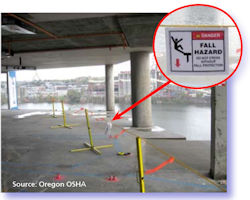Warning-Line Systems
A warning-line system consists of ropes, wires or chains, and supporting stanchions that mark off an area within which roofing work can be done without guardrails, personal fall-arrest systems, restraint systems, or safety nets.
Warning-line systems can only be used for roofing work on roofs that have slopes of 2:12 or less, vertical to horizontal. The purpose of the line is to warn roofers that they are near an unprotected edge.
The warning line must be at least 6 feet from an unprotected edge and meet the following criteria:
- Be flagged at least every 6 feet with high-visibility material.
- Be rigged so that the line is 34 to 39 inches from the walking/working surface.
- Have a minimum tensile strength of 500 pounds. Don't use plastic caution tape for a warning line.
- Be attached to each stanchion so that tension on one section of the line will not cause an adjacent stanchion to tip over. Stanchions must be able to support a force of at least 16 pounds applied horizontally in the direction of the roof edge without tipping over.
Those who do roofing work between the warning line and an unprotected roof edge must be protected with personal fall-arrest systems, restraint systems, guardrail systems, safety monitoring systems, or safety nets.
Knowledge Check Choose the best answer for the question.
6-4. While roofing work is taking place the warning line must be at least _____ feet from an unprotected edge.
You forgot to answer the question!

